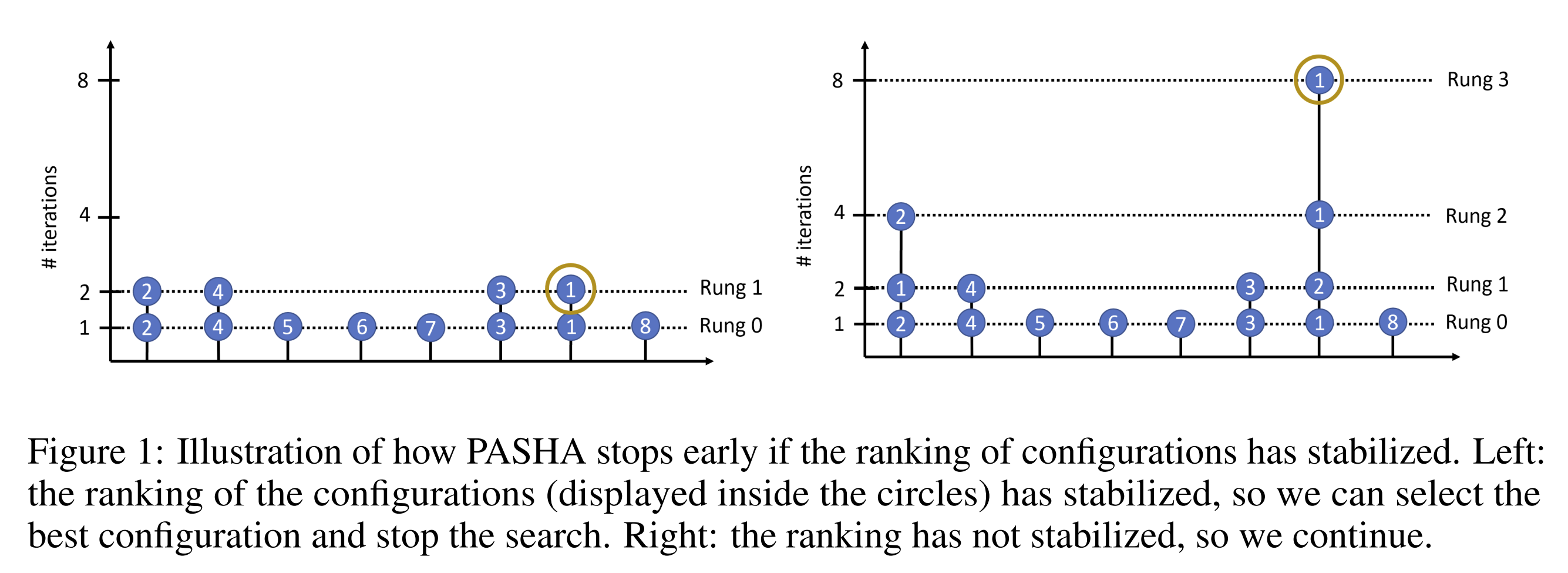PASHA: Efficient HPO and NAS with Progressive Resource Allocation
Hyperparameter optimization (HPO) and neural architecture search (NAS) are methods of choice to obtain the best-in-class machine learning models, but in practice they can be costly to run. When models are trained on large datasets, tuning them with HPO or NAS rapidly becomes prohibitively expensive for practitioners, even when efficient multi-fidelity methods are employed. PASHA is an approach designed to tackle the challenge of tuning machine learning models trained on large datasets with limited computational resources. PASHA extends ASHA and is able to dynamically allocate maximum resources for the tuning procedure depending on the need. The experimental comparison shows that PASHA identifies well-performing hyperparameter configurations and architectures while consuming significantly fewer computational resources than ASHA.
What is PASHA?
The goal of PASHA is to identify well-performing configurations significantly faster than current methods, so that we can then retrain the model with the selected configuration (in practice on the combined training and validation sets). By giving preference to evaluating more configurations rather than evaluating them for longer than needed, PASHA can lead to significant speedups while achieving similar performance as existing methods.
PASHA is a variant of ASHA that starts with a small amount of initial resources and gradually increases them depending on the stability of configuration rankings in the top two rungs (rounds of promotion). Each time the ranking of configurations in the top two rungs becomes inconsistent, PASHA increases the maximum number of resources. This can be understood as “unlocking” a new rung level. An illustration of how PASHA stops early if the ranking of configurations has stabilized is shown in Figure 1.

Given that deep-learning algorithms typically rely on stochastic gradient descent, ranking inconsistencies can occur between similarly performing configurations. Hence, we need some benevolence in estimating the ranking. As a solution, PASHA uses a soft-ranking approach where we group configurations based on their validation performance metric (e.g. accuracy).
In soft ranking, configurations are still sorted by predictive performance but they are considered equivalent if the performance difference is smaller than a value \(\epsilon\) (or equal to it). Instead of producing a sorted list of configurations, this provides a list of lists where for every position of the ranking there is a list of equivalent configurations. The concept is explained graphically in Figure 2. The value of \(\epsilon\) is automatically estimated by measuring noise in rankings.

How well does PASHA work?
Experimental evaluation has shown PASHA consistently leads to strong improvements in runtime, while achieving similar accuracies as ASHA. PASHA is e.g. three times faster than ASHA on NASBench201. Full experiments and further details are available in PASHA: Efficient HPO and NAS with Progressive Resource Allocation.
We provide an example script launch_pasha_nasbench201.py that shows how to run an experiment with PASHA on NASBench201.
Recommendations
PASHA is particularly useful for large-scale datasets with millions of datapoints, where it can lead to e.g. 15x speedup compared to ASHA.
If only a few epochs are used for training, it is useful to define rung levels in terms of the number of datapoints processed rather than the number of epochs. This makes it possible for PASHA to stop the HPO significantly earlier and obtain a large speedup.
A suitable stopping criterion for PASHA is the number of configurations that have been evaluated so far, but it can also be evaluated using stopping criteria based on the wallclock time. With time-based criteria PASHA would make an impact when the stopping time is selected as a small value.